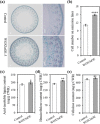Overexpression of PvWOX3a in switchgrass promotes stem development and increases plant height
- PMID: 34848686
- PMCID: PMC8633294
- DOI: 10.1038/s41438-021-00678-w
Overexpression of PvWOX3a in switchgrass promotes stem development and increases plant height
Abstract
Switchgrass (Panicum virgatum L.) is an important perennial, noninvasive, tall ornamental grass that adds color and texture to gardens and landscapes. Moreover, switchgrass has been considered a forage and bioenergy crop because of its vigorous growth, low-input requirements, and broad geography. Here, we identified PvWOX3a from switchgrass, which encodes a WUSCHEL-related homeobox transcription factor. Transgenic overexpression of PvWOX3a in switchgrass increased stem length, internode diameter, and leaf blade length and width, all of which contributed to a 95% average increase in dry weight biomass compared with control plants. Yeast one-hybrid and transient dual-luciferase assays showed that PvWOX3a can repress the expression of gibberellin 2-oxidase and cytokinin oxidase/dehydrogenase through apparently direct interaction with their promoter sequences. These results suggested that overexpression of PvWOX3a could increase gibberellin and cytokinin levels in transgenic switchgrass plants, which promotes cell division, elongation, and vascular bundle development. We also overexpressed PvWOX3a in a transgenic miR156-overexpressing switchgrass line that characteristically exhibited more tillers, thinner internodes, and narrower leaf blades. Double transgenic switchgrass plants displayed significant increases in internode length and diameter, leaf blade width, and plant height but retained a tiller number comparable to that of plants expressing miR156 alone. Ultimately, the double transgenic switchgrass plants produced 174% more dry-weight biomass and 162% more solubilized sugars on average than control plants. These findings indicated that PvWOX3a is a viable potential genetic target for engineering improved shoot architecture and biomass yield of horticulture, fodder, and biofuel crops.
© 2021. The Author(s).
Conflict of interest statement
The authors declare no competing interests.
Figures






References
-
- Shiratake K, Notaguchi M, Makino H, Sawai Y, Borghi L. Petunia PLEIOTROPIC DRUG RESISTANCE 1 is a strigolactone short-distance transporter with long-distance outcomes. Plant Cell Physiol. 2019;60:1722–1733. - PubMed
Grants and funding
- 31672479/National Natural Science Foundation of China (National Science Foundation of China)
- 31872879/National Natural Science Foundation of China (National Science Foundation of China)
- 31801429/National Natural Science Foundation of China (National Science Foundation of China)
- 31701496/National Natural Science Foundation of China (National Science Foundation of China)
LinkOut - more resources
Full Text Sources
Other Literature Sources
Research Materials

